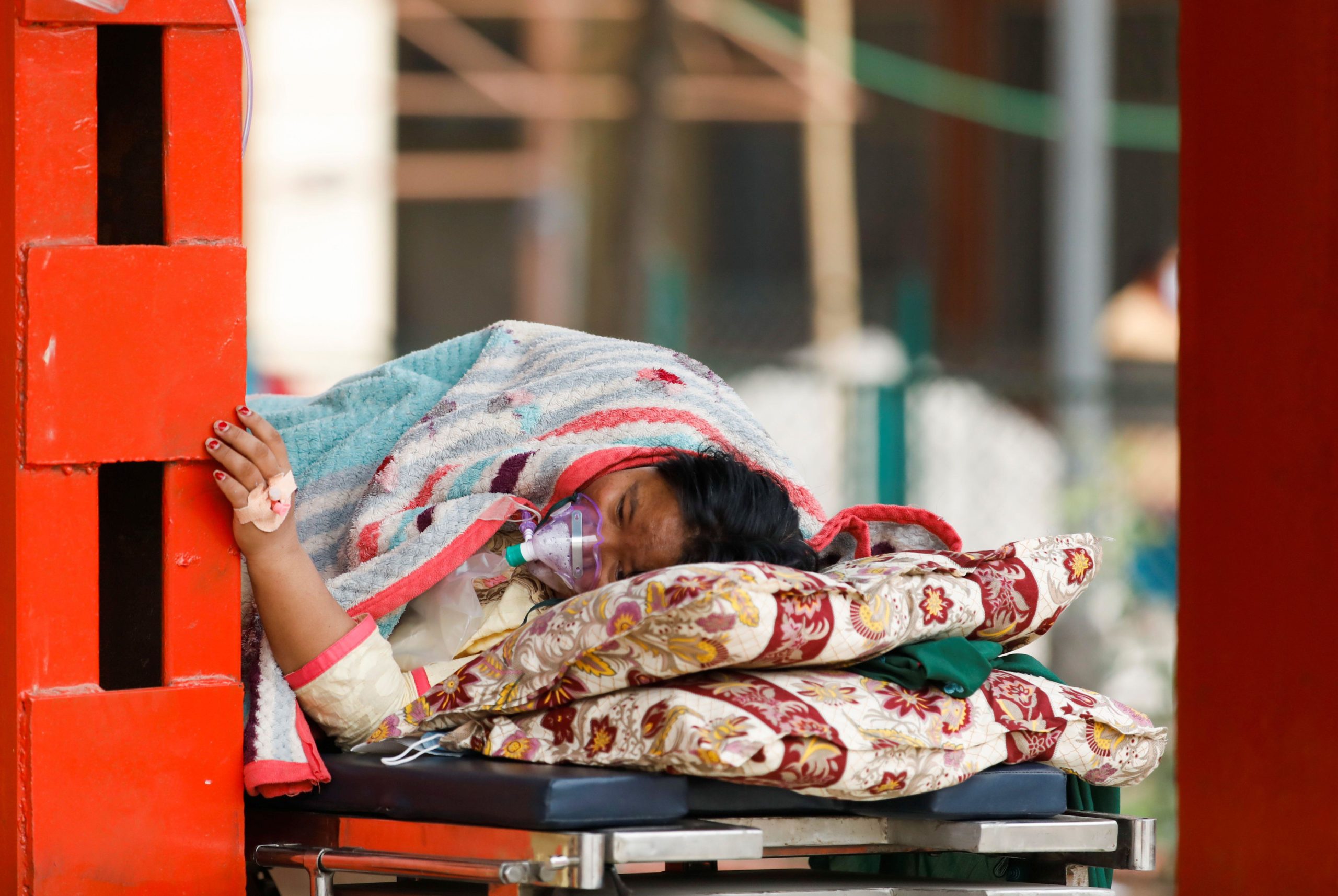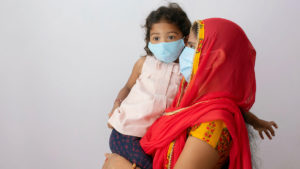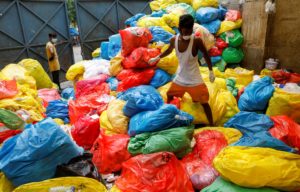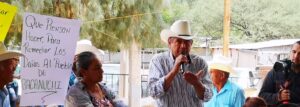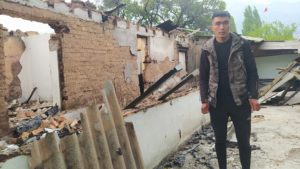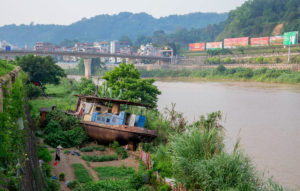The recent spike in Covid-19 cases in South and Central Asia has shone a harsh light on the lack of medical infrastructure for mountain communities. Tens of thousands of people in the Hindu Kush Himalayan region have been displaced in the name of development, but they have not benefitted. Infrastructure is costlier to build in the mountains, which is why healthcare infrastructure – in particular – should have been a priority. Unfortunately, the 250 million people living in these areas are poorer than their counterparts at lower altitudes. This means that their concerns are often ignored in policymaking. Few recent events have exposed this neglect as much as the Covid-19 pandemic.
India remains the global epicentre of the current Covid-19 wave. Limited testing facilities, especially in remote areas, mean that official data remains at best only indicative. The government of India is facing particular criticism for possibly suppressing numbers – both of infections and deaths – but this is the only data available.
By the end of the second week of May, over 25 million Indians had been infected with Covid-19 since the start of the pandemic; around 275,000 people had died. Over 18% of those tested were Covid-positive, many with the more transmissible variant of the virus, B.1.617. In Nepal, national positivity rates last week crossed 40%, prompting fears of mass deaths and hospitalisations if new infections are not curbed. In Pakistan, where daily deaths have been at a record high, cases fell in the second week of May though there are fears of a situation like India’s arising. Officials are still apprehensive about the spread of infections following the Eid festival, when families visit one another and large gatherings take place. In Central Asia, though Covid-19 infections have remained comparatively low, the economic impact on mountain communities has been devastating due to restrictions on tourism.
Premature declaration in Gilgit-Baltistan
In March 2021, officials in Gilgit-Baltistan (GB) said the region was free of Covid-19 but feared a surge of the virus once tourists returned. Given the abysmal rate of testing, it is impossible to be sure of the situation. On 14 May, the Pakistani government reported 273 tests had been conducted in the region in the previous 24 hours.
That rate has remained low throughout the pandemic. This is despite a study conducted after the first wave in GB in 2020 said: “[The] mountain community in Pakistan is not isolated from the impact of Covid‐19 pandemic… The aftermaths of this pandemic are likely to be severe unless mountain‐specific policies and responses for the mitigation of Covid‐19 impact and the revitalisation of mountain economy are developed.”
Little has been done to improve this. Given the shortage of basic infrastructure it is hard to upscale. In all of GB, there are 21 medical facilities with 126 beds. There are three labs testing for Covid-19 in the region. The government has pledged to provide 10 additional ventilators, which would take the number in the province up to 26.
According to a 2017 study by Amimah Fatima Asif, a medical officer at the district headquarter hospital in Skardu, the doctor to population ratio in GB is 1:4100, whereas the national statistic is 1:1206. Doctors are rarely available, there is a serious shortage of trained laboratory and operation theatre technicians and trained nursing staff, and no basic medicines are procurable, she wrote.
In the near-absence of government-run facilities, local volunteers and community leaders have become active. “In the first and second waves of the pandemic, our youth and volunteers remained vigilant to enforce the SOPs (standard operating procedures) in the villages by rendering round-the-clock duties,” said Muhammad Ayub, a community leader in Yasin valley of GB. They distribute essentials, fumigate homes and cars driving up from the plains, make and distribute masks and sanitisers, and check if tourists have negative Covid-19 test results.
“We used to make arrangements for the isolation of suspected passengers coming from cities,” said another volunteer, Muhammad Alam in Thoi village of Yasin valley. “We provided one spray machine to every union council of Yasin valley besides masks and sanitisers,” said Javed Iqbal, a member of local NGO Yasin Mahraka. “Our female volunteers are also active.”
Kashmir shows disconnect between government and reality
Community management of the Covid-19 pandemic is as important as medical and administrative measures, India’s central minister Jitendra Singh said on 14 May. He was speaking to his constituents in Udhampur in the Himalayan region of Jammu and Kashmir.
At a time when Covid-19 patients are dying due to a lack of oxygen and ventilators all over the region, Singh wanted community leaders to ensure no-one hoards oxygen cylinders at home. When residents pointed out there were not enough technicians to operate the few ventilators available, he said he had proposed a “short duration programme” to train more people. With India’s Covid-19 vaccination drive slowed down by the lack of vaccines, the minister was urged to speed up the process. His only response was that it was his “top priority”. The abysmal condition of hospitals in Jammu was ignored.
Jammu and Kashmir’s jails – overcrowded in response to a decades-long separatist movement – have turned into Covid-19 hotspots. On 12 May, a dissident leader Mohammad Ashraf Sehrai died in a hospital in Jammu after catching the virus in Udhampur jail. The administration’s response was to tighten curfew all over the Kashmir valley. Speaking in private, doctors in Srinagar complained that lorries containing oxygen cylinders were being held up by security forces.
The numbers are staggering. On 15 May, Jammu and Kashmir recorded 4,788 new Covid-19 cases in 24 hours, taking the tally of infected persons to 211,742. The official death toll rose to 2,672; of these, 60 had died the previous day.
Lockdowns in mountain communities are ineffective
The disconnect between the government and the people all over the Himalayas has become stark in the current Covid-19 wave. Across the region, the authorities’ default option has been to impose lockdowns with varying degrees of severity. They ignore the hardship this forces on people dependent on lorries carrying food, fuel and other necessities up the mountain roads. Worse, these methods are likely ineffective in controlling the spread of the virus. People live in close proximity, and they depend on social networks for their daily needs. With no alternative arrangements provided by governments, people are more likely to break the rules if the alternative option is to starve.
There are no isolation facilities and no basic public healthcare, let alone specialised treatment, in many mountainous areas. Instead, those falling ill are told to isolate themselves at home. A majority of people in the Himalayas live in one or two-room cottages, with very little ventilation so that the homes can be kept warm in winter. How can the infected isolate themselves in such homes? There is no answer from any central or state government.
This basic neglect of marginalised communities has been part and parcel of India’s pandemic response, even during the first wave of Covid-19. Even more problematically, frontline healthcare workers have received little support, and have borne the brunt of the work in dealing with the pandemic.
More hearses for Himachal
In the Indian state of Himachal Pradesh, the official Covid-19 death toll stood at 2,185 on 14 May. The number of people infected is now 157,862, with 56 deaths on 14 May.
The state government took two major decisions in the same week. It decided to buy more hearses to address the current shortage, and ordered the forest department to provide wood for cremations, free of cost. These ghoulish decisions came after an uproar when dead bodies were discovered floating in the Ganga in the neighbouring state of Uttar Pradesh. At the same time, the Himachal Pradesh government’s lockdown order left loopholes for virus transmission: weddings can still be held with gatherings of up to 20 people, and construction work can still go on. It has been the same, or worse, in all the Indian Himalayan states.
As elsewhere in India, the judiciary has been forced to step in. The Himachal High Court has ordered the government to “ensure equitable access to testing, medicine and hospital beds across the state”. There is no sign that the order is being followed.
During the first wave in 2020, voluntary organisations in the remote district of Lahaul and Spiti had done yeoman service to keep the virus away. “But this time, the wave is too strong,” said a resident who did not want to be identified. “We’re getting no help from the government. We cannot do everything ourselves.”
Kumbh Mela devastates Uttarakhand
Uttarakhand has become the Covid-19 epicentre of the Himalayas. The government permitted, and even encouraged, the Kumbh Mela which brought millions of Hindu pilgrims to the holy city of Haridwar from February to April, despite warnings from public health experts.
From the start of the pandemic to the end of March 2021, there had been 42,541 cases in the state’s nine mountain districts. Between 1 April and 8 May, this number reached 88,875.
The impact of the Kumbh Mela is clear, especially since many residents of the high-elevation districts had travelled to Haridwar for the holy dip in the Ganga. AK Dhwani, a schoolteacher in Tairia village near Corbett National Park, confirmed this, saying: “Many residents fell ill after returning from the Kumbh Mela. The situation worsened because many joined large wedding celebrations.” Residents of two villages in Betalghat block of Nainital district had gone together to the Kumbh festival. In both villages, half the residents (116 people) are now Covid-positive.
Testing and vaccination nearly impossible in the mountains
Locals dispute the official numbers. Many Covid-19 patients have not informed the authorities – they have self-medicated at home and stayed put. The few testing centres at high altitudes are either closed or crowded – most people fear catching the infection if they go to these centres. And then it takes up to a week to get the result. This means the infection spreads before the result arrives and the patient is isolated.
If that is the state of testing, the state of vaccination is worse. You must get online to book a vaccination slot: not an easy job in a region where mountains impact on wi-fi signals. As it is, India has too few vaccines.
No facilities for treatment at high altitudes
Even in normal circumstances, residents would go to the foothills for decent medical care. They would travel to either the state capital, Dehradun, or to Haldwani in the eastern part of the state. This is still what is happening. Doctors and paramedics working in high-altitude health centres confirmed that if they find a Covid-19 patient who needs institutional treatment, they send the patient to Dehradun or Haldwani. “We don’t have the facilities to treat them,” said one doctor who did not want to be identified for fear of losing his job.
What if someone needed an oxygen cylinder at home? “We don’t have oxygen cylinders for homes,” the doctor replied. “We don’t have the two nurses who are supposed to work here. They were told to work in Haridwar during the Kumbh Mela. They are still there.”
For residents of remote villages near the Tibet border, going to hospital can mean a drive of up to a day over rough roads. In the current circumstances, even this cannot guarantee treatment. Medical facilities in and around Dehradun have proved inadequate; the situation is worse in Haldwani. Oxygen cylinders and medicines are being sold on the black market at highly inflated rates. This has led to the same desperate pleas for help on social media that are seen all over India. Doctors at Haldwani’s Sushila Tiwari Hospital say they almost ran out of oxygen more than once in late April and early May, a critical issue for patients for whom oxygen can be the difference between life and death.
The state government has announced that it will install oxygen plants in hospitals and health centres in high-altitude districts. No work has started yet. The lone ray of hope in the state is a move by the disaster management department to work with residents to set up Covid-19 inspection committees that can monitor home isolation.
No infrastructure, no governance in Nepal
Covid-19 cases at the Everest base camp make global news, but citizens afflicted by the pandemic are interested only in news of hospital beds with oxygen. These are a rare commodity even in the capital Kathmandu. Villagers depend on primary health centres which have no oxygen cylinders, no doctors, and no testing facilities.
On 23 April, a few days before Nepal’s Prime Minister KP Oli lost a trust vote in Parliament, the Federation of Community Forests Users group took a major step forward. The group decided to hand over 1,400 offices across the country for quarantine of Covid-19 patients. The federation has over 22,000 forest users’ groups spread across Nepal.
Smaller efforts are starting. In Lalitpur in the Kathmandu valley, local NGO Chayasa Manka Khala has set up an isolation space in a community centre, with four beds with oxygen. “If our community members fall sick and we don’t get beds in hospitals, where shall we go? We have started this initiative before it is too late,” said Shyam Byanjankar, president of the NGO.
Bhutan stays safe, but for how long?
Bhutan remains an outlier in the Himalayan region for a variety of reasons. First and foremost of these is its health infrastructure. Bhutan spends the most in the region, as a proportion of its GDP, on healthcare. It also has a per capita GDP of over USD 3,000, higher by almost a third than Pakistan, India, Nepal or Bangladesh. With a strong public healthcare infrastructure and a small population, Bhutan managed to vaccinate its population at a higher rate than any other country in the world when it received vaccines from India.
Nevertheless the country cannot escape the hard fact of its geography. Bhutan shares borders with India and China. While there is no movement across the border with China, the one with India is critical for importing everything from heavy equipment, to meat, fruits and vegetables. Bhutan is deeply dependent on these imports, and these are coming from the Indian states of West Bengal and Assam where cases have increased rapidly after state elections.
Two recent cases in the border town of Samdrupjonkhar have created fresh tension. This was reminiscent of the situation last year when, despite a countrywide lockdown, Bhutan had a sudden spike of cases in its southern region. These included Indian personnel working on Bhutan’s roads and as training personnel to the Royal Bhutan Army. The prime minister made an emotional appeal on Facebook, reminding people especially of how the king has been working for their personally monitoring the situation, by surveying the southern districts.
The pandemic has highlighted the king’s role. Tourism has suffered massively, and it is the single biggest source of employment after agriculture in the country. Tourist numbers in 2020 were a tenth of those in 2019, and it is unlikely that 2021 will be much better. A royal grant, or kidu, has funded the National Resilience Fund, to provide a social safety net, or tens of thousands would be jobless. Large investments and loans to the tourism sector will have a significant impact on the Bhutanese tourism sector for years to come, even if the country manages to ride out the crisis better than its neighbouring countries.
Election rallies trump Covid-19, but what then?
The situation contrasts with neighbouring Assam, the Indian state which in February and March saw a slew of poll campaign rallies, mostly with maskless people jostling one another. India’s Prime Minister Narendra Modi, Home Minister Amit Shah and Rahul Gandhi – leader of the opposition Congress party – addressed many of these rallies. Himanta Biswa Sarma, BJP leader, then health minister and now chief minister of Assam, said in early April that there was no need to wear masks because there was no Covid-19 in the Himalayan state.
Such pretence is no longer possible. In the first 15 days of May, the state government officially reported 71,856 fresh cases. Over 8% of those tested during this period were positive.
Sarma now says he will ensure senior doctors are working the night shifts in government-run hospitals, since most Covid-19 patients have been dying at night. The lockdown has been tightened, though that means little outside urban areas.
Small states, big problems
Sikkim has the smallest and sparsest population of all the Indian states. It still has lost 192 people to Covid-19; 45 of these deaths have occurred since the beginning of May, forcing the authorities to impose a state-wide lockdown. Speaking on condition of anonymity, a senior Sikkim government official admitted that the lockdown may not be effective because “the virus has already entered villages”. Villagers would be forced to bring all seriously ill patients to the state capital Gangtok, the only city with a sizeable number of intensive care unit beds fitted with oxygen support. The high court has asked the state government what it plans to do about the “woefully inadequate” facilities to treat Covid-19 patients. There has been no response as yet.
In the northeastern state of Arunachal Pradesh, local journalist Tongam Rina has calculated that there are 20,180 vials to vaccinate 18-44-year-olds in a state with an estimated population of 1.75 million. More than half of the population is likely to fall into the 18-44 year age group. Doctors at state capital Itanagar told Rina on 4 May that they would not be able to cope if there were even 100 serious patients in the city.
Anger, violence and repression
As elsewhere in India, grief-crazed relatives of patients who had died due to a shortage of oxygen attacked doctors in an Arunachal Pradesh hospital on 1 May. In response, doctors went on a state-wide strike on 7-8 May, right in the middle of the Covid-19 wave.
In Manipur, also ruled by the Bharatiya Janata Party (BJP) which rules at the centre, the party’s state unit chief S Tikendra Singh died of Covid-19 on 13 May. Activist Erendro Leichombam and journalist Kishorchandra Wangkhem posted on Facebook, mocking BJP leaders for advocating cow dung and cow urine as Covid-19 resistors. The two were arrested under the National Security Act. The state, meanwhile, saw its highest single-day surge on 15 May, with 730 fresh cases and 10 deaths. Since the beginning of May, residents have been using social media to make desperate pleas for hospital beds.
Mizoram’s Deputy Chief Minister Tawnluia has tested positive for Covid-19. The state’s official tally of 7,382 cases by 15 May is lower than that of many other states, but many residents ascribe this to the lack of testing.
No facilities, confusing orders
The Tripura government has announced a nine-day “corona curfew” from 17 May, though details of the order show little difference from lockdown orders elsewhere. West Tripura district, which includes state capital Agartala, has a Covid-19 positivity rate of 9.25%. Weddings with up to 50 guests can still be held during the “curfew”. The state had 4,102 active Covid-19 cases on 16 May.
At a government-run orphanage in Agartala, 36 girls have tested positive. A resident of the city said there was no place in the orphanage for anyone to be isolated, nor any other isolation facility in the city.
Well-known journalist Patricia Mukhim, a resident of Meghalaya capital Shillong, wrote two Facebook posts on 17 May – one bemoaning the shortage of coffins and another the shortage of ambulances. Christian-majority Meghalaya witnessed a Covid-positivity rate of 17.5% on 13 May – one out of every six people tested had the virus. Ampareen Lyngdoh, senior leader of the opposition Congress party, pointed out on 14 May that the entire state had only 387 beds hooked up to oxygen, while there were 4,000 active cases the same day, with many patients needing oxygen support.
No end to Covid-19 in the Chittagong hills
The Chittagong Hill Tracts (CHT), where the Himalayas peter out into the sea, are among the most popular holiday destinations of Bangladesh now out of bounds due to Covid-19. A recent survey has shown that 61% of CHT residents do not have enough food to last the next seven days. Another study found that while most of the indigenous communities living in CHT are following Covid-19 guidelines, some are facing shortages of masks and sanitisers.
Many lack the documents they need to access subsidised food or other essentials. But even those with documents are reporting shortages in government-run shops. Hardly any of the mountain villages have healthcare facilities that can deal with serious Covid-19 infections, which means patients must be transported for hours over rough roads.
Few cases, but fewer tourists in Central Asia
The current Covid-19 wave has not impacted countries in Central Asia to the same extent as South Asia. Much of the impact has been indirect, as tourism has come to a halt in the mountain regions where most tourist attractions are located. While this has taken away the major source of income in many parts of the region, “only 13% of vulnerable households in Batken oblast [a mountainous region in Kyrgyzstan] reported receiving external assistance [underscoring] the extent to which rural households may be cut off from support” during the pandemic, the Asian Development Bank has said.
During the first Covid-19 wave in 2020, ethnic Chinese Hui residents (also called Dungan) of Milanfan village in Kyrgyzstan’s Chui region suffered greatly – around 100 of the 6,000-member community died. When government healthcare facilities failed to cope, residents created and ran a facility themselves, from buying medicines and oxygen to hiring doctors.
With reporting from Joydeep Gupta in India, Atika Rehman and Peer Muhammad in Pakistan, Ramesh Bhushal in Nepal, Zobaidur Rahman in Bangladesh and Ryskeldi Satke in Kyrgyzstan
